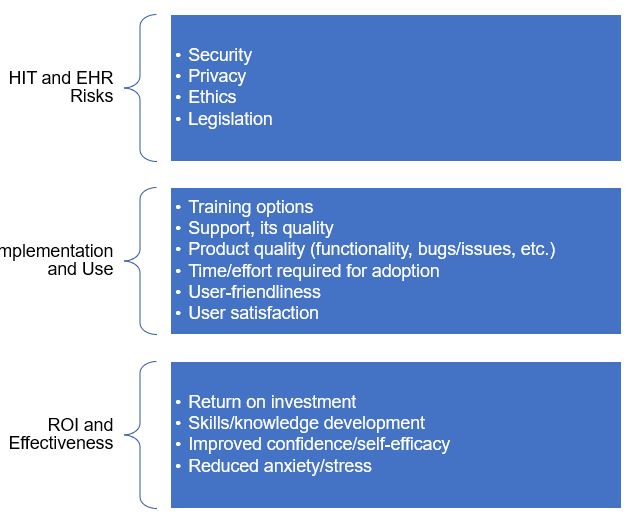SimChart is an Electronic Healthcare Record (EHR) system that was developed to teach nurses to work with EHRs (Elsevier, 2013). The evaluation framework should take the specifics of SimChart into account. It is noteworthy that there appears to be a shortage of frameworks meant for EHR simulations; the present research has failed to detect one. However, it may be possible to develop a framework based on the recommendations intended for simulations, EHRs, and healthcare information technology (HIT) in general. The proposed framework is presented in Figure 1 and discussed in detail below.

HIT and EHR tend to introduce specific risks that need to be controlled (Amer, 2015; Middleton et al., 2013). As a result, security and privacy issues should be included in the framework. Similarly, the ethical and legal concerns are of importance. To evaluate these aspects, it is necessary to review all the risks that the use of SimChart poses for stakeholders and ensure that appropriate risk management mechanisms are present. The examples of the latter include security passwords, backups, and so on (Amer, 2015). Thus, the HIT and EHR risks are the first aspect of the proposed framework (see Figure 1).
From the perspective of the ease of implementation and use, multiple factors should be considered. The quality of the product can be included in this group of evaluation features: the software needs to be fully functional and cause minimal problems, which should facilitate both its adoption and use. Another pertinent element is the presence of support and its quality. Moreover, an important feature that should ensure fast adoption and effective use is the presence of various training materials, lesson plans, and evaluation tools. The amount of time and effort that might be required for the adoption is another significant factor; to assess it, it may be helpful to collect the reports of the nurses who have already used the product. The nurses might also help to provide some data on the user-friendliness of SimChart. A review of the specifics of the program’s interface may also help to evaluate the ease of the product’s use. Finally, the overall satisfaction of users can be regarded as an important assessment feature (Khalaila, 2014). In summary, the second element of the framework is rather extensive and requires reviewing the product from multiple perspectives that can help to determine its usability.
Finally, the system’s return on investment and effectiveness need to be evaluated. The latter element incorporates multiple factors. First, the system’s capacity to improve users’ ability to operate EHR needs to be considered; this factor can be evaluated with the help of objective studies or subjective reports of the nurses who have already tried the product (Foronda, Liu, & Bauman, 2013). Second, the changes in the users’ self-efficacy and confidence are of importance since these outcomes are typically expected from nursing simulations (Foronda et al., 2013; Khalaila, 2014). Similarly, some attention can be paid to the reduction of nurses’ anxiety and stress related to the use of EHR. Thus, the effectiveness of the product depends on its ability to produce the desired outcomes, and the assessment of its return on investment is required to determine the feasibility of its adoption.
In summary, the proposed framework reviews the product from multiple perspectives that appear to be significant. Overall, it is suggested to consider the possible risks, opportunities, and outcomes of SimChart. The framework may be changed in future to the benefit of the project.
References
Amer, K. (2015). Informatics: Ethical use of genomic information and electronic medical records. OJIN: The Online Journal of Issues in Nursing, 20(2). Web.
Elsevier. (2013). SimChart brochure. Web.
Foronda, C., Liu, S., & Bauman, E. (2013). Evaluation of simulation in undergraduate nurse education: An integrative review. Clinical Simulation in Nursing, 9(10), e409-e416. Web.
Khalaila, R. (2014). Simulation in nursing education: An evaluation of students’ outcomes at their first clinical practice combined with simulations. Nurse Education Today, 34(2), 252-258. Web.
Middleton, B., Bloomrosen, M., Dente, M. A., Hashmat, B., Koppel, R., Overhage, J. M.,… Zhang, J. (2013). Enhancing patient safety and quality of care by improving the usability of electronic health record systems: Recommendations from AMIA. Journal of the American Medical Informatics Association, 20(e1), e2-e8. Web.